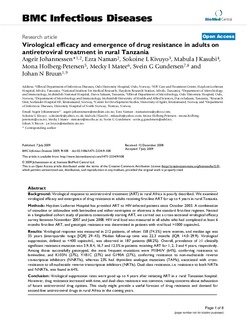| dc.contributor.author | Johannessen, Asgeir | |
| dc.contributor.author | Naman, Ezra | |
| dc.contributor.author | Kivujo, Sokoine | |
| dc.contributor.author | Kasubi, Mabula | |
| dc.contributor.author | Holberg-Petersen, Mona | |
| dc.contributor.author | Matee, Mecky | |
| dc.contributor.author | Gundersen, Svein Gunnar | |
| dc.contributor.author | Bruun, Johan | |
| dc.date.accessioned | 2010-03-26T13:00:36Z | |
| dc.date.issued | 2009 | |
| dc.identifier.citation | Johannessen, A., Naman, E., Kivuyo, S., Kasubi, M., Holberg-Petersen, M., Matee, M., et al. (2009). Virological efficacy and emergence of drug resistance in adults on antiretroviral treatment in rural Tanzania. Bmc Infectious Diseases, 9(1), 108. doi: 10.1186/1471-2334-9-108 | en |
| dc.identifier.issn | 1471-2334 | |
| dc.identifier.uri | http://hdl.handle.net/11250/135294 | |
| dc.description | Article published in the journal: Bmc Infectious Diseases
Also available from: http://dx.doi.org/10.1186/1471-2334-9-108 | en |
| dc.description.abstract | BACKGROUND:Virological response to antiretroviral treatment (ART) in rural Africa is poorly described. We examined virological efficacy and emergence of drug resistance in adults receiving first-line ART for up to 4 years in rural Tanzania.METHODS:Haydom Lutheran Hospital has provided ART to HIV-infected patients since October 2003. A combination of stavudine or zidovudine with lamivudine and either nevirapine or efavirenz is the standard first-line regimen. Nested in a longitudinal cohort study of patients consecutively starting ART, we carried out a cross-sectional virological efficacy survey between November 2007 and June 2008. HIV viral load was measured in all adults who had completed at least 6 months first-line ART, and genotypic resistance was determined in patients with viral load >1000 copies/mL.RESULTS:Virological response was measured in 212 patients, of whom 158 (74.5%) were women, and median age was 35 years (interquartile range [IQR] 29-43). Median follow-up time was 22.3 months (IQR 14.0-29.9). Virological suppression, defined as <400 copies/mL, was observed in 187 patients (88.2%). Overall, prevalence of [greater than or equal to]1 clinically significant resistance mutation was 3.9, 8.4, 16.7 and 12.5% in patients receiving ART for 1, 2, 3 and 4 years, respectively. Among those successfully genotyped, the most frequent mutations were M184I/V (64%), conferring resistance to lamivudine, and K103N (27%), Y181C (27%) and G190A (27%), conferring resistance to non-nucleoside reverse transcriptase inhibitors (NNRTIs), whereas 23% had thymidine analogue mutations (TAMs), associated with cross-resistance to all nucleoside reverse transcriptase inhibitors (NRTIs). Dual-class resistance, i.e. resistance to both NRTIs and NNRTIs, was found in 64%.CONCLUSION:Virological suppression rates were good up to 4 years after initiating ART in a rural Tanzanian hospital. However, drug resistance increased with time, and dual-class resistance was common, raising concerns about exhaustion of future antiretroviral drug options. This study might provide a useful forecast of drug resistance and demand for second-line antiretroviral drugs in rural Africa in the coming years. | en |
| dc.format.extent | 248904 bytes | |
| dc.format.mimetype | application/pdf | |
| dc.language.iso | eng | en |
| dc.publisher | BMC Publishing | en |
| dc.title | Virological efficacy and emergence of drug resistance in adults on antiretroviral treatment in rural Tanzania | en |
| dc.type | Journal article | en |
| dc.subject.nsi | VDP::Medical disciplines: 700::Clinical medical disciplines: 750::Communicable diseases: 776 | en |
| dc.source.pagenumber | 108 | en |
| dc.source.volume | 9 | en |
| dc.source.journal | Bmc Infectious Diseases | en |
| dc.source.issue | 1 | en |
